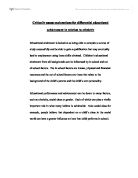There are many factors inside of school that can affect the differential progress of boys and girls. The ways in which mixed schools are organised can reinforce to pupils the importance and significance of gender roles. For example, it may be taken for granted that registers are separated into boys and girls; seating plans may be based on gender; PE and games may be segregated.
Also, staffing can affect the progress of boys and girls. Teaching has always been a female dominated profession, has in recent years become even more female dominated. In the 1960’s, 25% of primary school teachers were male; this has fallen 2 about 16 %. There are many reasons for this: teachers’ pay has not kept pace with that of other professions, men have to be more concerned than in the past about possible allegations of sexual abuse and more teachers are on temporary contracts or working part time. The result of this is that boys have fewer role models among teachers and these are likely to be senior staff. While girls have more role models, in many schools female teachers are noticeably missing from certain subject areas, especially science and technology.
Another factor is what goes on inside the classroom. Teachers give boys and girls different kinds of attention (Spender 1983). Girls are praised for appearance, good behaviour and neatness of work, but these qualities are valued less highly than what is seen as individuality and creativity in boys. Girls tend to be more conformist in school. While this may be approved of by teachers, it can also be taken as evidence of limited or average ability. Boys are more likely to take risks in their work; poor work is taken as evidence of laziness, not lack of ability, and occasional success or effort as being evidence of being a ‘bright spark’. This contributes to the self – perception of boys and girls; boys tend to overestimate their abilities, girls to underestimate theirs.
Learning resources can also affect differential achievement between boys and girls. Traditional textbooks, some of which are still used in schools, often contain sexist materials and images in which the woman’s role is trivialised, e.g. a science textbook may show boys carrying out experiments while girls watch or are not present, examples used may be more likely to appeal to boys than girls and the achievement of women and the importance of gender issues may be played down. Newer textbooks and other resources consciously take account of gender issues and promote equality, avoiding the sexism of earlier books. The use of resources such as science equipment may be dominated by boys. Teachers do not always challenge the physical domination of spaces by aggressive boys.
Another factor is what goes on inside the classroom. Teachers give boys and girls different kinds of attention (Spender 1983). Girls are praised for appearance, good behaviour and neatness of work, but these qualities are valued less highly than what is seen as individuality and creativity in boys. Girls tend to be more conformist in school. While this may be approved of by teachers, it can also be taken as evidence of limited or average ability. Boys are more likely to take risks in their work; poor work is taken as evidence of laziness, not lack of ability, and occasional success or effort as being evidence of being a ‘bright spark’. This contributes to the self – perception of boys and girls; boys tend to overestimate their abilities, girls to underestimate theirs.
Learning resources can also affect differential achievement between boys and girls. Traditional textbooks, some of which are still used in schools, often contain sexist materials and images in which the woman’s role is trivialised, e.g. a science textbook may show boys carrying out experiments while girls watch or are not present, examples used may be more likely to appeal to boys than girls and the achievement of women and the importance of gender issues may be played down. Newer textbooks and other resources consciously take account of gender issues and promote equality, avoiding the sexism of earlier books. The use of resources such as science equipment may be dominated by boys. Teachers do not always challenge the physical domination of spaces by aggressive boys.







